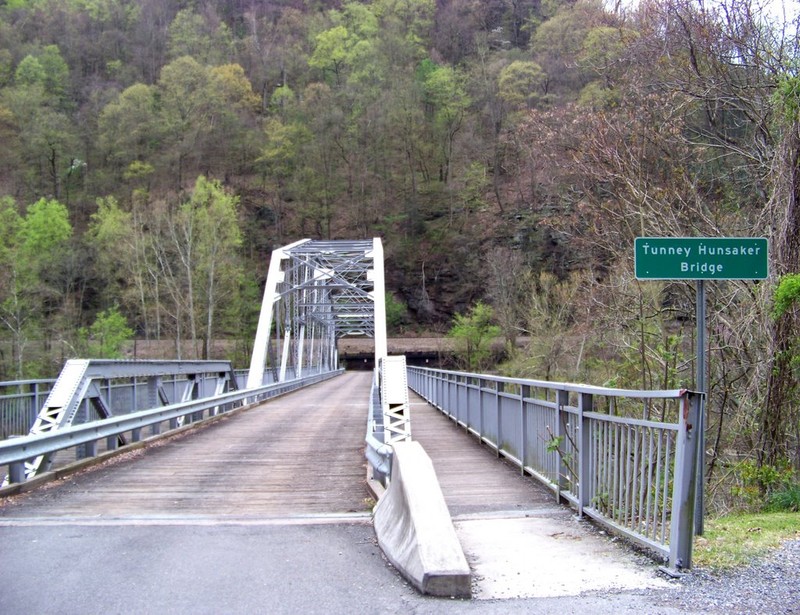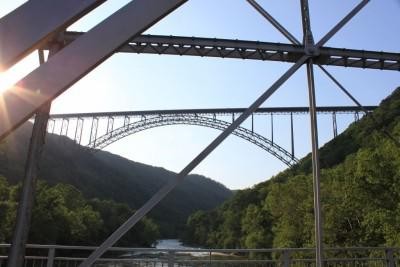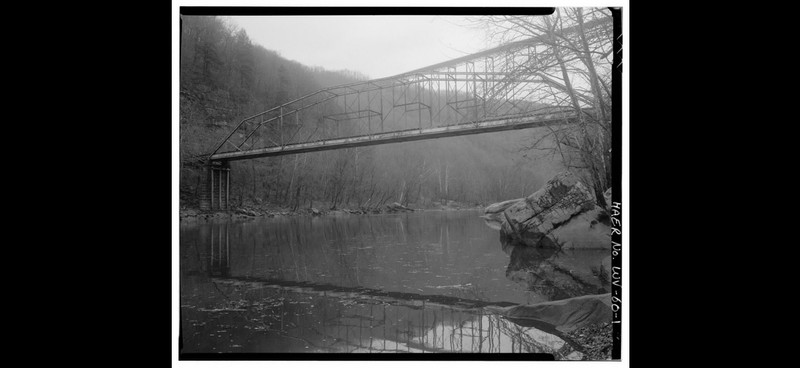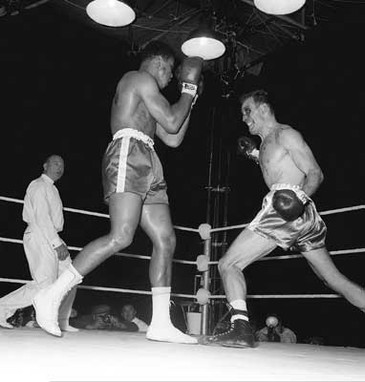Fayette Station and Tunney Hunsaker Bridge
Introduction
Text-to-speech Audio
Fayette Station was a reasonably sized mining town composed of Fayette and, just across the river, South Fayette. Like all mining towns in the New River Gorge, Fayette Station was connected to the outside world via the Chesapeake and Ohio Railroad (C&O). As the town expanded in the late nineteenth century, the omnipresent C&O railroad became one of two ways to access the town. The Fayette Station Bridge was completed in 1889 and allowed vehicular traffic to reach Fayette Station. The bridge was the first in the New River Gorge to cross the New River and was a harbinger of the automobile’s replacement of trains as the primary form of transportation. Fayette Station declined over the course of the twentieth century and the bridge followed suit. The completion of the New River Gorge Bridge in 1977 directly led to the closure of the Fayette Station Bridge. However, the opening of the New River Gorge National River area caused a renewed interest in the area and the bridge. The structure was almost completely rebuilt in 1997, and a pedestrian walkway on each side was added. The bridge was also renamed to the Tunney Hunsaker bridge after a Fayette County native who fought against Muhammad Ali in the latter man’s first professional boxing bout. The bridge is an important reminder of transportation and infrastructure in the New River Gorge.
Images
The Tunney Hunsaker Bridge.

The bridge is dwarfed by its successor, the New River Gorge Bridge.

The bridge before reconstruction in 1997.

Hunsaker and Ali facing off in their 1960 fight.

Backstory and Context
Text-to-speech Audio
The town of Fayette Station effectively consisted of two settlements: Fayette, and just across the river, South Fayette. Fayette was established first, around 1873. Martin Blume opened a mine and negotiated right of way with the Chesapeake & Ohio (C&O) railroad. The right of way agreement granted Blume and any descendants free passenger service on the train for as long as it was in use. Fayette expanded quickly as workers flocked from near and far to mine in the area. Blume founded the E.G. Blume Coal Company and transferred ownership of the mine to this entity. Blume himself served as superintendent while L.D. Miller was the foreman.
Fayette was a moderately sized mining town and employed twenty-three men. Eight men worked directly with picks, eight men operated mining machines, and the other seven men handled transporting coal using a small locomotive and two mules. Despite Fayette’s relatively humble beginnings, by 1875 the town was large enough to have its own post office. The most significant building in Fayette was the three-story Blume Company Store. The first floor sold goods to miners, the second floor had offices for the E.G. Blume Coal Company, and the top floor was used as living quarters for the Blume family. A saloon in the basement was the center of social life in town and even included gambling devices, pool tables, and a slot machine. A curious auxiliary business of the E.G. Blume Coal Company was the production and sale of coffins, which were marketed through the New River Gorge. Beyond the company businesses, there was only one other business in Fayette: a car garage. This garage portended the significance of Fayette as the nineteenth century drew to a close.
Transportation in and around the New River Gorge was dominated almost exclusively by trains. The C&O railroad had tracks on each side of the New River with one track entering and one track leaving the gorge. This began to change as the automobile roared into the United States transportation scene. A bridge was constructed between Fayette and what would become South Fayette in 1889. This structure was built using a style known as Pennsylvania through truss. Wrought iron was used for main supporting elements with a laminated wood deck supporting traffic. Only two stone piers support the 420 foot long structure. The exact details surrounding the building of the bridge are lost to history. A frequently cited builder of the bridge is the Virginia Bridge and Iron Company from Roanoke, Virginia, though a historic photo of the bridge plate suggests that the Wrought Iron Bridge Company of Canton, Ohio was the builder. One possibility is that the Virginia Bridge and Iron Company purchased and sized materials for the bridge but then subcontracted the actual construction to the Wrought Iron Bridge Company. In any case, the bridge was the first span to cross the New River in the gorge.
The Fayette Bridge linked Fayette and South Fayette, which merged and changed their name to Fayette Station in 1894. State Route 82, one of the first paved roads in the area, was instrumental in driving traffic to and through Fayette Station. The road was built in the early 1900s and widened and repaved in 1918. The towns continued to grow until they boasted 410 residents in 1910. By this point, Fayette Station had expanded to incorporate many nearby mines, such as the Ajax, Michigan, Royal, and Newlyn mines. However, as the twentieth century wore on, Fayette Station began to decline. The gradual closure of mines in the area led to a series of mass exoduses. When the Fayette Station depot and freight house were destroyed in a 1960s fire, the town faded for good. One of the last extant reminders of Fayette Station, the foreman’s house, was destroyed in 1990 to make room for a rafting access point.
Despite Fayette Station’s decline, the Fayette Station Bridge has remained an icon in the New River Gorge. At first, the bridge also began to deteriorate alongside Fayette Station. In 1977, the opening of the New River Gorge Bridge seemed to spell the end of vehicular traffic on the Fayette Station bridge. As the New River Gorge Bridge cut directly across the gorge itself, there was no longer a need to traverse the many slow and time-consuming setbacks to reach the bottom of the gorge before ascending on the other side. Fayette Station Bridge was closed to both vehicular and pedestrian traffic. Just a year later in 1978, the New River Gorge National River was established. This garnered renewed interest in the area as a recreational and historical location.
Recognizing the importance of the first bridge over the New River, a project was initiated to rehabilitate the Fayette Station Bridge. Almost the entirety of the bridge was replaced with modern materials and sidewalks for pedestrians were added. Practically speaking, the current bridge is a replica loosely based on the original, rather than a rehabilitation. The new bridge was renamed the Tunney Hunsaker bridge, after a Fayette County resident who was the first person to fight in a professional boxing match against Muhammad Ali. After his boxing career, Hunsaker returned to Fayette County where he served as police chief of Fayetteville for over thirty years. Though the town of Fayette Station is long gone, the Tunney Hunsaker Bridge stands as a reminder of the first bridge to cross the New River and one of the most significant vehicular routes in the gorge.
Sources
"Axes Ground On Roads." Beckley Post-Herald (Beckley) May 21st 1971. 4-4.
"Cotton Hill, Fayetteville to be Linked." The Raleigh Register (Beckley) February 7th 1937. 8-8.
"Deeds Recorded In Fayette Co.." The Raleigh Register (Beckley) August 10th 1970. 9-9.
"Fayette County Bridge." The Raleigh Register (Beckley) November 18th 1977. 4-4.
Fayette Station Bridge, Historic American Engineering Record. January 1st 1996. Accessed June 6th 2021. https://tile.loc.gov/storage-services/master/pnp/habshaer/wv/wv0400/wv0432/data/wv0432data.pdf.
Fayette Station Bridge, National Bridge Inventory. January 1st 2013. Accessed June 6th 2021. https://historicbridges.org/wvirginia/fayettestationbridge/nbisheet.pdf.
Fayette Station Road, National Park Service. January 6th 2020. Accessed June 6th 2021. https://www.nps.gov/neri/planyourvisit/fayette-station-road.htm.
"Gorge Bridge Progressing." The Raleigh Register (Beckley) October 29th 1976. 21-21.
Holth, Nathan. Fayette Station Bridge, Historic Bridges. June 5th 2014. Accessed June 6th 2021. https://historicbridges.org/bridges/browser/?bridgebrowser=wvirginia/fayettestationbridge/.
"Inspection on Fayette Bridge Asked." The Charleston Daily Mail (Charleston) February 1st 1968. 9-9.
Morgan, Bob. Fayette Station Bridge, Bridge Hunter. September 14th 2020. Accessed June 6th 2021. https://bridgehunter.com/wv/fayette/fayette-station/.
"Nature Tours Are Slated." Beckley Post-Herald (Beckley) April 2nd 1974. 11-11.
"New River Enjoyed By Many." Beckley Post-Herald (Beckley) October 4th 1976. 9-9.
"New River in Flood." The Messenger (Beckley) July 18th 1916. 5-5.
Parkinson, Nick. Muhammad Ali vs. Tunney Hunsaker: The first fight of the Greatest, ESPN. October 29th 2015. Accessed June 6th 2021. https://www.espn.com/boxing/story/_/id/13999218/muhammad-ali-vs-tunney-hunsaker-first-fight-greatest.
"Planning Conference Scheduled This Week On Proposed Recreation Lake In Fayetteville." Beckley Post-Herald (Beckley) February 28th 1960. 10-10.
Poliquin, Bud. Muhammad Ali's first pro opponent was Tunney Hunsaker, who never did forget 'The Greatest', Syracuse. March 22nd 2019. Accessed June 6th 2021. https://www.syracuse.com/poliquin/2013/10/muhammad_alis_first_pro_oppone.html.
Seletyn. WV History: Fayette Station Bridge, Seletyn. February 5th 2020. Accessed June 6th 2021. https://seletyn.com/2020/02/05/wv-history-fayette-station-bridge/.
Stahlgren, Lori et al. Historical Archaeological Survey: New River Gorge National River and Gauley River National Recreation Area. Lexington, KY. Kentucky Archaeological Survey, 2007.
Tate, Ben. 2012. Bridge Hunters. Accessed June 6th 2021. https://bridgehunter.com/wv/fayette/fayette-station/.
Library of Congress. Accessed June 6th 2021. https://www.loc.gov/resource/hhh.wv0432.photos/?sp=1.
